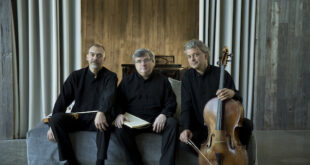Experiencing Secret Byrd, a dramatized early-music concert staged by Death of Classical, is a good exercise for someone whose job is to describe things. Describing involves explaining, and explaining typically requires categorizing. What to do with an artistic event that resists categorization?
Director Bill Barclay created a performance event that places us at a clandestine Catholic Mass in the early 17th century. William Byrd, the great English composer, was at that time writing music for just such services. With persecution driving Catholics underground, they had to keep their religious gatherings out of sight. Byrd himself, though Catholic, was able to maintain his position in society through his connections with Queen Elizabeth I and his reputation as, especially after the death of Thomas Tallis, the greatest English composer of his day.
William Byrd in All His Vocal and Instrumental Glory
The Abendmusik String Ensemble, here a six-person consort of viols, alternated with mostly a cappella singing by the five-person Cathedra Ensemble in music by Byrd, some of it expressly written for a Mass. The viols provided rich readings of Byrd’s instrumental music, resounding, like the voices, magnificently in the long, narrow (and dark) tunnel that runs the length of the damp catacombs. The mix of sacred and secular music included a stunning performance of Byrd’s “Elegy on the Death of Thomas Tallis” by mezzo-soprano/alto Aryssa Burrs, and some secular instrumental music as well.

The centerpiece of the music was Byrd’s Mass for 5 Voices, written probably about 1594 and likely never publicly performed in his day. This is exquisitely impassioned music, and the five vocalists of the Washington, D.C.-based Cathedra Ensemble did it justice. You really feel the composer’s heart and soul in it.
The theatrical aspect of the concert included moments of powerful drama, though without any dialogue to speak of — the “story” was all in the Mass, the ritual (set around a dining table laden with food and drink), and the intermittent movements about the space by the singers and a “priest.”
That space with its chill humidity was unkind to the viols, which had some trouble staying in good tune – though this was a major detriment only at the end when they not-quite harmoniously accompanied the singers. In any event the skill on hand was unequivocally impressive. The singers, richly costumed in period dress, and the musicians, at home on three sizes of viola da gamba – ancient instruments that are seeing something of a renaissance amid the current fitful, but real, popularity of early music – brought Barclay’s vision to multidimensional life.

Early-Music Shivers
I’ve seen a number of concerts in the Catacombs, and they’re always special, but never before anything like this staged event. It did fit right in with the performance history and ethos of Green-Wood; the historic 478-acre garden cemetery in Brooklyn often hosts immersive outdoor shows (at Halloween, for example). Secret Byrd was, however, the only occasion on which I’ve been truly frightened in that great cemetery – for a reason I won’t reveal in case the project is staged again (it originated at the Washington National Cathedral in Washington, D.C.). And that includes the time my wife and I found ourselves locked inside Green-Wood after closing time.
Secret Byrd – however you may describe it – was produced by Death of Classical. Visit their website for upcoming concerts at Green-Wood Cemetery and other spectral venues.
 Blogcritics The critical lens on today's culture & entertainment
Blogcritics The critical lens on today's culture & entertainment




